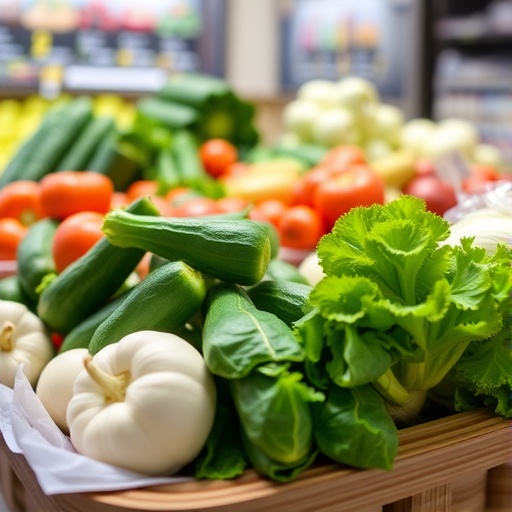In the rapidly evolving domain of food science, maintaining both safety and quality during storage has become paramount, particularly for fresh produce subjected to minimal processing. A recent breakthrough study published in Food Science and Biotechnology delves into these very concerns, focusing intensely on Korean seasoning vegetables—a staple in many households—and how pathogenic bacteria growth is influenced under cold storage conditions. This intricate research unravels complex interactions between microbial dynamics and storage parameters, shedding light on food preservation methods that could redefine industry practices globally.
Minimal processing of vegetables, which involves techniques such as washing, cutting, and packaging without extensive chemical or heat treatment, has gained popularity due to consumer demand for fresh-like convenience foods. However, this processing approach poses inherent risks; it can disrupt the natural microbial barriers of vegetables, facilitating the proliferation of harmful bacteria. The study rigorously evaluates how cold storage, a common preservation strategy, modulates the growth of pathogenic bacteria in such minimally processed Korean seasoning vegetables, offering vital insights into prolonging shelf life while safeguarding public health.
The authors systematically interrogate the growth patterns of typical pathogens known to compromise food safety, including species such as Listeria monocytogenes and Escherichia coli, under refrigerated conditions. By maintaining these vegetables at low temperatures traditionally considered inhibitory to bacterial growth, the research quantifies the bacterial load over time, drawing correlations with observable changes in food quality parameters. This dual focus provides a comprehensive understanding of how minimal processing interfaces with microbiological risks and sensory attributes, an area often overlooked in standard food safety assessments.
One of the study’s notable contributions is its detailed analysis of physicochemical changes accompanying cold storage. Variables like pH, moisture content, and enzymatic activity were assiduously monitored to elucidate their influence on bacterial ecology within the food matrix. The results underscored that subtle shifts in these parameters can create niches for selective bacterial proliferation, challenging the dogma that refrigeration alone suffices to inhibit foodborne pathogens. This revelation urges reconsideration of current cold storage protocols, especially for products prone to rapid spoilage and microbial contamination.
Beyond microbial quantification, the investigation also scrutinizes sensory quality indices—such as texture, color, and aroma—that directly affect consumer acceptance. The findings indicate a complex trade-off: while some treatments effectively suppress bacterial growth, they may inadvertently accelerate quality degradation, diminishing the appeal and marketability of the vegetables. This delicate balance emphasizes the necessity for optimization strategies that harmonize microbial safety with organoleptic excellence in minimally processed produce.
Importantly, the study harnesses state-of-the-art microbial enumeration techniques and molecular diagnostics, surpassing traditional culture methods, to identify and track pathogen strains with precision. This methodological advancement enhances detection sensitivity and accuracy, enabling real-time profiling of microbial succession during storage. The application of such high-resolution tools paves the way for tailored interventions and more reliable risk assessments in food processing environments.
As consumer trends shift towards fresh, convenient, and health-conscious eating habits, minimally processed food markets are expanding rapidly. However, with this expansion comes the imperative integration of scientific insights into regulatory frameworks and industrial standards. The research presented prompts industry stakeholders to reevaluate hygienic practices, cold chain management, and packaging technologies to mitigate pathogen risks without compromising product integrity.
The role of refrigeration, while central, is portrayed in this work as a single component of a multifaceted preservation system. The study urges that cold storage should be combined with complementary hurdles—such as modified atmosphere packaging, natural antimicrobial agents, and advanced sanitation measures—to establish robust barriers against foodborne pathogens without sacrificing nutritional and sensory qualities.
Furthermore, the research highlights regional dietary nuances by focusing on Korean seasoning vegetables, which possess unique compositional and structural characteristics influencing microbial behavior. This specificity enriches global food safety dialogues by underscoring the need for localized studies that address culturally significant food items, thereby enhancing food security on a broader scale.
The interface of food microbiology and biotechnology is vividly illustrated in this study, demonstrating how interdisciplinary approaches can unravel intricate preservation challenges. The knowledge gained sets a precedent for future endeavors aiming to innovate minimal processing techniques and devise smarter cold storage solutions tailored to diverse vegetable types and consumption patterns.
Given the environmental implications of food waste, extending the shelf life of fresh vegetables through informed microbial management has profound sustainability benefits. This research indirectly contributes to reducing spoilage-related losses, minimizing the carbon footprint of food systems, and fostering responsible consumption—a trinity critical for addressing global food security issues.
In conclusion, this comprehensive evaluation of pathogenic bacterial growth kinetics and food quality degradation during cold storage in minimally processed Korean seasoning vegetables represents a milestone in food science research. It not only elucidates the inherent vulnerabilities of minimally processed produce under refrigeration but also charts a path forward for innovative preservation strategies that align safety with sensory satisfaction.
The compelling findings resonate beyond academia, appealing to food manufacturers, policymakers, and consumers alike, advocating for science-driven reforms in fresh food handling and storage. As the food landscape evolves, studies like this serve as linchpins in the collective endeavor to deliver safe, high-quality, and sustainable nourishment to a growing global population.
Subject of Research: Pathogenic bacteria growth and food quality during cold storage in minimally processed Korean seasoning vegetables.
Article Title: Evaluation of pathogenic bacteria growth and food quality during cold storage in Korean seasoning vegetables subjected to minimal processing.
Article References:
Han, A., Woo, Y. & Lee, SY. Evaluation of pathogenic bacteria growth and food quality during cold storage in Korean seasoning vegetables subjected to minimal processing. Food Sci Biotechnol (2025). https://doi.org/10.1007/s10068-025-02002-x
Image Credits: AI Generated




